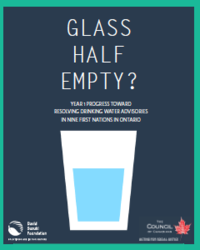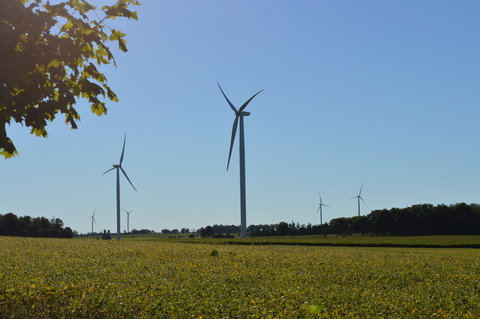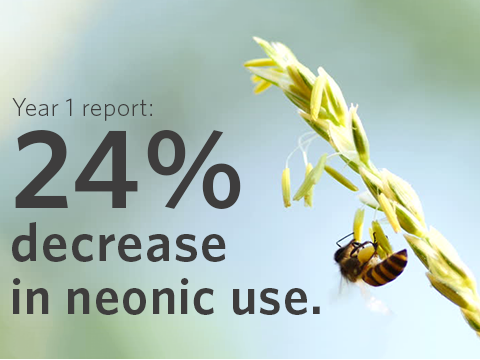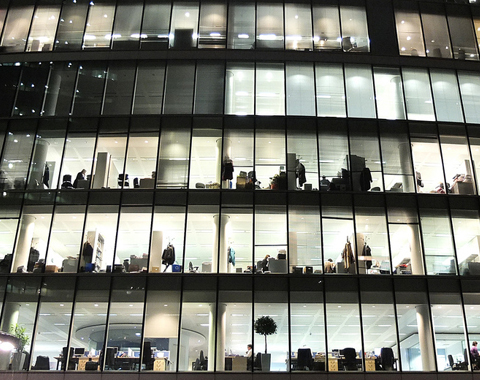David Suzuki's Blog, page 17
February 9, 2017
Report - Glass half empty? Year 1 progress toward resolving drinking water advisories in nine First Nations in Ontario

The David Suzuki Foundation, in collaboration with the other organizations, assessed progress toward ending long-term Drinking Water Advisories in nine First Nations in Ontario. Data were compiled from interviews, meetings, conferences, reports and media releases, to assess the progress and challenges First Nations face in attaining clean and safe drinking water. Each organization provided input and expertise based on work it has conducted on this issue.
Hey! Want more DSF? Join David Suzuki on Facebook

February 8, 2017
How to save energy in the kitchen

Once you heat up a burner and your dish is almost cooked, turn it off and coast on the stored heat. (Credit: Kenny Corbin via Flickr)
Large appliances -- refrigerator, range and dishwasher -- use the most energy in the kitchen. But there are lots of little ways to conserve.
Size matters
Match the cooking appliance to the job. Heating up a toaster oven uses less electricity than an entire conventional oven. Place big pots on big burners -- and don't forget the lids.
Coast on waste heat
Once you heat up a burner and your dish is almost cooked, turn it off and coast on the heat stored in the pot. Keep the lid on to help conserve heat and continue the cooking process. (Cast iron does this well.)
Cool leftovers
Made enough for lunch tomorrow? Planning to freeze a batch of soup? Cool leftovers to room temperature before you store them in the fridge or freezer. Placing hot food in a cold fridge heats up the air inside, making it work harder.
Plan ahead
Before you get chopping and slicing, think about everything you need from inside the fridge or freezer. Avoid standing with the door open, letting cold air escape! Go in once, get all the ingredients you need. Put stuff back inside all at the same time, too.
Refrigerate only what's necessary
If you can't recall the last time you cleaned out your fridge, it's probably time to clean out your fridge. Only refrigerate food that needs it (PDF). Perishables include dairy products, most fruits and veggies (except tomatoes!), meats and fish. But bread and some condiments, such as vinegar, just take up space. Air circulates better in uncrowded fridges and freezers. That makes them more energy-efficient and keeps food fresher longer.
What other steps do you take to conserve energy in the kitchen?
Sincerely,
Lindsay Coulter, a fellow Queen of Green
Hey! Want more DSF? Join David Suzuki on Facebook

February 6, 2017
Rob Stewart: A rare gift to the oceans and the world
Along with people in Canada and around the world, I am heartbroken with the loss of Rob Stewart.
There was no one like Rob and the loss is profound. Those of us who were privileged to know him will never forget his passion and his magnetism. Rob drew you in. He was one of the truest and most influential advocates for the oceans and for the Earth.
Most people have heard of Rob because of Sharkwater, his epic documentary that shone a spotlight on shark finning and the global decline of sharks. Not exactly a "sexy" topic. And how is it relevant again? But Rob broke it down, and drew us in.
Shark finning is the callous practice of slicing off fins and tails of sharks -- often while they're still alive -- to sell. Fins and tails are much more lucrative than shark meat, and thus make more economic sense to stockpile onboard. As a result, the stumpy bodies of sharks are usually dumped overboard at sea, sometimes still alive and attempting to swim as they spiral down towards the bottom of the ocean.
More than 90 per cent of sharks are now gone, mostly due to overfishing. And this has upset the ocean's delicate balance. Reefs with fewer sharks, we now know, are less healthy overall. These top predators help shape the food web, and their decline causes a ripple effect throughout the ecosystem and beyond, with possible implications extending even to climate.
But what struck me most about Sharkwater was its beauty. How could a film about something as grisly as shark finning and as depressing as the collapse of the oceans be beautiful? How could it be something the public would actually want to see? And yet I witnessed, over and over, how people who had never swum in the ocean before or who couldn't have cared less about fish suddenly felt called to action, suddenly felt compelled, as if the cause were now impossible to ignore, to do something. And many of them did -- supporting ocean initiatives, increasing seafood awareness, showing Sharkwater in classrooms. Some even formed their own NGOs.
Sharkwater contributed to mounting international public pressure to ban shark finning and protect sharks, resulting in changes to policy and law in numerous countries and on the international scale, as well as in municipalities across Ontario, Rob's home province.
While Sharkwater will likely be what Rob is remembered for, I was even more impressed with his next film, Revolution. Rob realized that in order to address the oceans and ultimately sharks, we had to address what's upstream: us. He understood that change had to come from a fundamental understanding of our place and potential in the world, and of our interconnectedness and interdependence on all living things.
And Rob knew that true understanding must happen with the heart.
Ten years after its release, people still remember Sharkwater. They still talk about it with energy and emotion. And this is because Rob did something most environmental films -- and dare I say, the environmental movement -- fail to do: inspire us. He reminded us why we are privileged to live here on Earth. He showed us that the world is still a breathtaking and mysterious place that deserves to exist. In short, he did what stats and data cannot: he showed us the beauty. He had this uncanny ability to see it where others might not -- in sharks, in our depleted world, in us... and then, to share it.
The last time I communicated with Rob was through email in December. I'd reached out to him as I sometimes did just to check in and see what he was up to -- there was always something cooking. But the purpose of my last email was really because I was disheartened. I wanted to know how he kept going, kept being hopeful. After all, the oceans were still a mess, the world was still getting hotter and now things had just gotten a whole lot more complicated with the recent U.S. election. To put it simply: I was down.
As he always did, with whomever he met, Rob drew me back in. He explained why we had to focus on the world we want rather than the battles we fight, because that is what will bring us together, instead of dividing us. Once again he pointed to the beauty in the world and the excitement in our purpose. And of course, he shared his latest, ambitious projects.
From the last line of the last email he ever wrote me: "Don't feel disillusioned! The challenge is calling the best in us."
May this be a call to all of us who are still privileged to live in this world: Let's see Earth's beauty and give back to it, a privilege Rob never took for granted.
Rob forged the lead. Let's live up to his enormous spirit.
Hey! Want more DSF? Join David Suzuki on Facebook

February 2, 2017
Ontario's first community wind farm powers almost 7,000 homes

Credit: Miranda Fuller
Miranda Fuller looks over the 10 turbines on Gunn's Hill Wind Farm in southern Ontario's Oxford County, a lush region of farmland and small cities between London and Kitchener. "They're magical!" she says.
The project, which started running late last year and now produces enough electricity to power some 6,700 local homes, is Ontario's first community-sponsored wind farm. If the word "magical" is not wholly accurate -- the turbines are no illusion, after all -- it does capture some of Gunn's Hill's uniqueness. From many points of view, it's an extraordinary undertaking.
Fuller, 24, grew up in Oxford and, after studying environmental ethics at nearby Wilfrid Laurier University, became communications director at the Oxford Community Energy Co-operative, one of the organizations that gave Gunn's Hill life. (Other key partners were the Six Nations of the Grand River and project developer Prowind Canada Inc.)
She tells me the co-op of just 180 members raised a staggering $9 million -- much of it from investments of $1,000 to $10,000 by individuals living in the county. Ron Seftel, CEO of investor Bullfrog Power says, "Local folks put in a ton of work" to make Gunn's Hill possible. Today, almost half its bonds and shares, 49 per cent, are in the hands of Oxford residents and businesses. Community-based yet wonderfully ambitious, it is the largest renewable energy co-op project to gain approval in Ontario. It's also Canada's first wind initiative to feature both co-op and Indigenous ownership.
Beyond its significant size -- it will supply an impressive 15 per cent of Oxford's 100 per cent renewable electricity goal -- the project creates a bond between citizens and their power generation. "Too often, people are cut off from their power supply," Fuller says. "It's important to see your energy source. Seeing the turbines helps you connect with the energy you're using." Living close to the windmills -- and in some cases gaining employment from them -- gives locals a stake in the system and makes them more likely to support pro-renewable public policy.
Gunn's Hill also helps conserve agricultural land. Fuller tells the story of one landowner family that joined the co-op because they've run a farm for six generations and want to protect it from development for as long as possible. With 20-year contracts underwriting the turbines, putting them on property means it can't be paved for at least two decades, if not longer.
The project wasn't without obstacles. During its development, Fuller recalls, "Some locals didn't support it. But since it was built, we're not seeing much pushback. People fear what they don't know. So you need to give people factual information. There's been a shift in attitude since the project became operational." One piece of information that diminishes opposition is the fact that windmills offer residents income. "Local people's investment in wind does ease contention," Fuller says.
In a phone interview with the David Suzuki Foundation, Fuller explains why wind speaks to her personally. "I absolutely worry about climate change. Denying it would be foolish. Wind is one of the technologies that can help us get off fossil fuel. It helps us become energy-independent."
She doesn't hesitate to offer advice to other municipalities contemplating local power projects: "Be prepared to be surprised by the community's passion for renewables. Keep moving forward -- the end is worth it. They're magical, the wind turbines. They bring a lot of hope."
Hey! Want more DSF? Join David Suzuki on Facebook

Statement on B.C. NDP Clean Growth and Climate Action Plan
VANCOUVER -- The David Suzuki Foundation is encouraged by several elements of the B.C. NDP's Climate Action Plan, released today. The strategy addresses several major concerns that will put B.C. on track to achieving emissions reductions. These elements include:
• A commitment to reduce emissions and achieve emissions-reductions targets for 2030 and 2050.
• Investing in climate change solutions, including public transit, energy efficiency, clean technology and initiatives that will reduce B.C.'s dependence on fossil fuels.
• Working with the Climate Leadership Team to implement the complete list of recommendations.
"It's promising to see the B.C. NDP's commitment to public transit infrastructure and clean tech," said foundation science and policy director Ian Bruce. "Investing in a clean energy future represents a significant economic opportunity. In particular, we're happy to see the transportation funding framework that the David Suzuki Foundation advocated for in our 2016 report Breaking gridlock incorporated into the B.C. NDP platform."
The NDP's plan also commits to meeting the federally mandated $50 per tonne price on carbon pollution by 2022. Although this target is in line with national carbon pricing, the foundation wants to see the next government of B.C. commit to a plan beyond 2022.
More detail is needed about the financial elements of the plan. These questions should be answered as the election unfolds.
"Climate leadership is not a sprint," Bruce said. "B.C. needs to commit to going the distance, improving on current targets and clearing the air on key issues like liquefied natural gas. How does LNG fit in with any plan to reduce emissions? We're not sure yet. How will the next government ensure that methane emissions from this sector are accurately measured and reduced? All parties still need to answer these questions. We look forward to hearing what the other parties have planned on climate action. Now, more than ever, B.C. has the opportunity to lead on environmental solutions and invest in a sustainable economy."
- 30 -
Media contact:
Emily Fister, Climate Change & Clean Energy Communications Specialist
David Suzuki Foundation
604-374-4102
Hey! Want more DSF? Join David Suzuki on Facebook

Indigenous people are fighting for us all

Protesters at Standing Rock (Credit: Joe Brusky via Flickr)
In the 1990s, the David Suzuki Foundation embarked on a program to develop community economic projects with coastal First Nations. Between 1998 and 2003, my wife and foundation co-founder, Tara Cullis, established relationships with 11 coastal communities from the tip of Vancouver Island to Haida Gwaii and Alaska, visiting each several times.
She encountered unemployment and a desperate need for jobs and economic development in every community. Then came pressure for pipeline projects and court-mandated consultation with First Nations. Federal and provincial governments began offering huge financial incentives for pipeline approvals. But opposition remained strong because some things are more important than money.
By 2012, people along the B.C. coast were alarmed at the prospect of oil tankers plying their waters if the Northern Gateway pipeline were to be built. When the National Energy Board scheduled a meeting with the Heiltsuk people of Bella Bella, community members greeted them on arrival, drumming, singing and protesting peacefully. Rather than hear concerns from those with the most at stake, frightened board members cancelled the meeting.
Fossil fuel industry executives, chamber of commerce members and politicians promote pipelines for their supposed economic benefits. I often hear that one CEO or another is a good man who goes to church, takes his family camping and loves nature. Many are. But the economic system they operate in places no value on anything "sacred."
Nothing is more sacred than that which provides life and health: clean air, safe water, healthy soil, photosynthesis. Yet damaging natural systems on which those conditions depend is seen as irrelevant, external to economic considerations. Thoughtful, sensitive corporate executives can't let their love of children or nature affect their decisions because consequences like pollution and habitat degradation are simply the "costs of doing business."
Canada's prime minister and environment minister are parents. They must understand what scientists are saying about climate change, so they know their children's future could hold climate chaos and catastrophe. Indigenous people speak of the responsibility to remember and honour lessons from ancestors and consider what we will leave for children and future generations. It's something every politician should heed, but political reality leads to different priorities and actions.
In 2013, Mi'kmaq activists built a camp near Elsipogtog, New Brunswick, to oppose fracking as a threat to water, which it has proven to be. Authorities responded with shocking levels of force.
For years, farmers and Indigenous people have opposed the Peace River Site C dam, saying it's unnecessary for B.C. energy needs, which could be better met with conservation, geothermal and other renewable energy. They argue the dam would desecrate sacred First Nations sites and flood priceless farmland. Although the B.C. government rejected the dam decades earlier, its proponents never gave up, and the government eventually resurrected the plan, without considering what many regard as sacred.
Many First Nations oppose open-net salmon farms on the B.C. coast as threats to wild salmon that have fed them and shaped their culture for millennia. Rather than demanding improved aquaculture methods, politicians choose to ignore the pleas of First Nations, abrogating their responsibility to protect wild marine species in order to accept the profit imperative of transnational corporations.
A fundamental problem is that governments represent people, so ministers of forests, fisheries, oceans or the environment don't act on behalf of forests, fish, oceans or the environment. They put human use of those resources first, seemingly blind to the bigger picture.
The Occupy and Idle No More movements were about values and world views. Now, dedicated Sioux people have galvanized tens of thousands of supporters worldwide with their defence of water against the U.S. Dakota Access pipeline project. It's ironic that after a history of facing genocidal policies, North America's original peoples are leading a struggle on behalf of us all. They're objecting to economic and political agendas that fail to elevate the sacred as one of our most important values so our constructs and institutions (economy, market and corporations) respect the natural systems we depend on.
We must enshrine nature as the source of our lives, livelihoods and happiness. Recent protests are about securing and protecting the most elemental needs of all people. Many Indigenous peoples are on the front lines, for everyone. I support them, with gratitude.
Hey! Want more DSF? Join David Suzuki on Facebook

January 31, 2017
How to be a Butterfly Ranger

Flower gardens are beautiful but what butterflies need most are "host" plants for their caterpillars to eat. (Credit: Lindsay Coulter)
You can help butterflies and bees!
Starting in February, the David Suzuki Foundation is recruiting residents from five cities across the country to join The Butterflyway Project. Keen volunteers will be trained as local Butterfly Rangers to help create patches of butterfly- and bee-friendly habitat throughout their neighbourhoods.
Join The Butterflyway Project in Victoria, Richmond, Montreal, Markham and Toronto. (Don't feel left out if your city isn't on the list. Subscribe to my digest for tips on creating a butterfly haven where you live!)
Applications for the Victoria troop will be accepted February 2 to 19.
After one or two inspiring days of training (duration depends on city), Rangers will go back to their neighbourhoods with a mission: Plant native wildflowers and shrubs in yards, schoolyards, boulevards and parks -- and have fun!
What butterflies need most are "host" plants for their caterpillars to eat. Flower gardens are beautiful --- many butterflies feed on nectar from a variety of plants. But they may ONLY lay their eggs on -- and their caterpillars will ONLY eat -- a few species. For example, of the 70 butterfly species recorded on Vancouver Island, 10 prefer to lay eggs on oceanspray or stinging nettle.
Want to wow your family, friends and neighbours with more butterfly facts AND create much-needed habitat? Be a Butterfly Ranger!
Once a Ranger troop plants a dozen or more pollinator patches in a neighbourhood, it will get official David Suzuki Foundation Butterflyway designation, including signs and inclusion in the national Butterflyway Project map.
What steps will you take to help butterflies and bees -- leaving the leaves, keeping some of your yard messy, planting host and nectar plants?
Sincerely,
Lindsay Coulter, a fellow Queen of Green (and Victoria Butterfly Ranger trainer)
P.S. We're also looking to partner with local groups, businesses and institutions willing to support a local troop of Rangers by helping spread the word -- even get their hands dirty! Learn more here.
Hey! Want more DSF? Join David Suzuki on Facebook

Demand better seafood labelling

According to Canadian guidelines, a package with the "rockfish" label could contain one of more than 100 species, some of which are endangered and others sustainably caught. Canadians deserve to know more about their seafood.
Hey! Want more DSF? Join David Suzuki on Facebook

January 30, 2017
Phase-in of Ontario's neonic regulation hits new milestone

The total number of Ontario acres planted with treated corn and soybean seeds declined by 24 per cent. It’s a good start. But more than three million acres in Ontario are still planted with neonic-treated corn and soybean seed, and that’s unacceptable.
First report on neonic-treated seed sales measures widespread use
Looking for information about Canadian pesticide use and sales is frustrating. But in a leap forward for transparency, Ontario has published its first report on sales of corn and soybean seed treated with neonicotinoid insecticides ("neonics"), as required by the recently-amended provincial pesticide regulation.
Parts of Europe have banned neonics to protect pollinators. In 2015, Ontario introduced North America's first regulatory restrictions on them. Its more modest approach addresses neonic-treated corn and soybean seed, implicated in catastrophic bee die offs during planting in Ontario and Quebec. The Ontario government has pledged to reduce these uses of neonics by 80 per cent.
Tracking progress towards the 80 per cent reduction goal needs timely reporting on sales of treated seeds. Federal regulations require pesticide manufacturers to report on product sales each year. Health Canada summarizes this data in annual pesticide sales reports. But the Health Canada reports don't capture sales of neonic-treated seeds. Furthermore, they are not very detailed and only list whether total sales of each pesticide's active ingredient is more or less than 50,000 kilograms. And the most recent edition reports pesticide sales in 2014.
Ontario's report on seed sales fills an important gap. It shows that in 2016, 54 per cent of soybean seed and 76 per cent of corn seed sold in the province (by mass) were neonic-treated. This represents a modest reduction from pre-regulation levels. The total number of acres planted with treated corn and soybean seeds declined by 24 per cent. It's a good start. But more than three million acres in Ontario are still planted with neonic-treated corn and soybean seed, and that's unacceptable.
The province is phasing in the new regulation. Full implementation should drive deeper reductions in the use of neonic-treated seeds. Further action may be necessary to meet the 80 per cent reduction target. In 2016, farmers could buy neonic-treated seed for half an area planted with corn or soybeans with few restrictions. They could use treated seed for more than half if a pest assessment showed a relevant insect threat. Starting in 2017, treated seeds can only be used if justified by a pest assessment.
Meanwhile, Health Canada recently proposed a ban on agricultural use of one neonic (imidacloprid), citing concerns that it poses an unacceptable risk to aquatic biodiversity in Canadian lakes and rivers. Federal reviews of two other neonics are underway with results expected later in 2017.
A Canada-wide ban on neonics is an appropriate extension of Ontario's early action on treated seeds. We're starting to turn a corner away from the indiscriminate use of these chemicals. But we need to pick up the pace.
You can help! Tell Health Canada you want imidacloprid -- and all other neonics -- banned Canada-wide.
Ban imidacloprid -- and all other neonics
Hey! Want more DSF? Join David Suzuki on Facebook

January 26, 2017
We need to work less to live better

(Credit: Justin Lynham via Flickr)
Since the 1950s, almost everything about work in the developed world has changed dramatically. Rapid technological advances continue to render many jobs obsolete. Globalization has shifted employment to parts of the world with the lowest costs and standards. Most households have gone from one income-earner to at least two. Women have fully integrated into the workforce, albeit often with less-than-equal opportunities, conditions and pay. A lot of our work is unnecessary and often destructive -- depleting resources, destroying ecosystems, polluting air, water and soil, and fuelling climate change.
Yet we're still working the same or more hours later into life within the same outdated and destructive system, furiously producing, consuming and disposing on a wheel of endless growth and conspicuous consumption. The gap between rich and poor is widening and working people -- and those who can't find work -- are falling further behind, crushed by growing debt, increased competition for scarce jobs and declining real wages and benefits.
Although unions deserve credit for many gains working people have enjoyed over the past century or more, they also merit some criticism. In the face of technological advances and globalization, unions have failed to fight for steadily reduced work hours, focusing instead on higher wages and better benefits -- although lately it's more fighting to prevent drastic cuts to jobs, wages and benefits.
Many people are tired, too stretched to become politically engaged or even to spend as much time with family and friends as they'd like, and the grinding consumer cycle doesn't bring them real joy or fulfilment.
As with climate change, gradual reform could have forestalled the drastic actions now needed, but addressing the issue now will do far more good for a greater number of people than doing nothing -- and it will become more difficult and costly the longer we put off necessary action.
It's absurd that so many people still work eight hours a day, five days a week -- or more -- with only a few weeks' vacation a year, often needing two incomes to support a household. Our economic system was developed when resources seemed plentiful if not inexhaustible, and physical infrastructure was lacking. We need an overhaul to meet today's conditions rather than those that existed decades ago when we were unaware of many of the potential negative consequences of our actions.
Research points to many advantages of reforms such as reduced work hours and universal basic income. In Gothenburg, Sweden, workers at a care home for the elderly were put on a six-hour workday as part of a two-year controlled study. Although hiring 15 new employees to cover the workload drove costs up by about 22 per cent, spending was reduced in areas like covering sick leave, which dropped by 10 per cent. Workers reported health improvements at rates 50 per cent higher than workers at institutions with regular working hours. Patient care also improved. Women with children benefited substantially.
Many global warming impacts could also be lessened with small work-hour reductions, through shorter workweeks and increased vacation time, a 2013 report from the Center for Economic and Policy Research, a Washington-based think-tank, concluded.
"By itself, a combination of shorter workweeks and additional vacation which reduces average annual hours by just 0.5 per cent per year would very likely mitigate one-quarter to one-half, if not more, of any warming which is not yet locked-in," report author and economist David Rosnick said.
A four-day workweek (as David Suzuki Foundation staff enjoy) cuts pollution and emissions from commuting and, in many cases, reduces energy consumption. When Utah went to a four-day week for government employees in 2007, the state saved $1.8 million in energy costs alone. Fewer commutes led to an estimated reduction of more than 11,000 tonnes of CO2.
A better work-life balance also brings many individual and societal advantages. Family life is strengthened, people have more time for creative or educational pursuits, and happier, rested employees are more productive. As more people share in available jobs, social service costs go down and more people are able to contribute to economic prosperity.
A lot needs to be done to reform our economic systems and to address critical issues like pollution and climate change. Reducing work hours is one way to make substantial gains.
Hey! Want more DSF? Join David Suzuki on Facebook

David Suzuki's Blog
- David Suzuki's profile
- 247 followers




